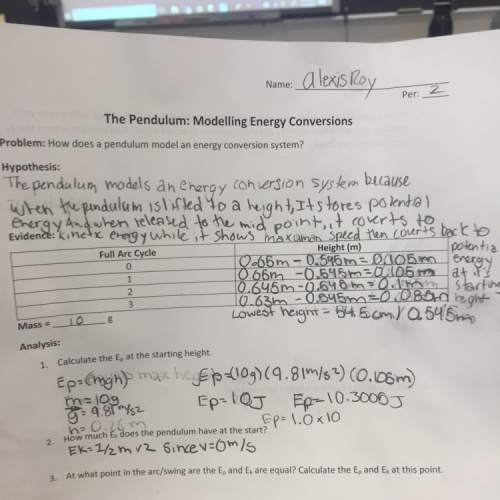
Camden constructs a model of a double convex lens using two clear plastic circles that are round on one side and flat on the other. He attaches the circles at the edges. How does his model look?
A
It is thicker on the left side and thinner on the right side.
B
It is thicker in the middle and thinner at the edges.
C
It is completely flat from the middle to the edges.
D
It is thinner in the middle and thicker on the edges.

Answers: 2
Another question on Physics

Physics, 22.06.2019 08:00
Aheat engine running backward is called a refrigerator if its purpose is to extract heat from a cold reservoir. the same engine running backward is called a heat pump if its purpose is to exhaust warm air into the hot reservoir. heat pumps are widely used for home heating. you can think of a heat pump as a refrigerator that is cooling the already cold outdoors and, with its exhaust heat qh, warming the indoors. perhaps this seems a little silly, but consider the following. electricity can be directly used to heat a home by passing an electric current through a heating coil. this is a direct, 100% conversion of work to heat. that is, 19.0 \rm kw of electric power (generated by doing work at the rate 19.0 kj/s at the power plant) produces heat energy inside the home at a rate of 19.0 kj/s. suppose that the neighbor's home has a heat pump with a coefficient of performance of 4.00, a realistic value. note: with a refrigerator, "what you get" is heat removed. but with a heat pump, "what you get" is heat delivered. so the coefficient of performance of a heat pump is k=qh/win. an average price for electricity is about 40 mj per dollar. a furnace or heat pump will run typically 200 hours per month during the winter. what does one month's heating cost in the home with a 16.0 kw electric heater? what does one month's heating cost in the home of a neighbor who uses a heat pump to provide the same amount of heating?
Answers: 2

Physics, 22.06.2019 14:00
Why is rain likely when warm, moisture-laden air meets cold air? a) the lighter warm air will rise and cool down, causing condensation and rain. b) the cold air moves faster and pushes the warm air away, causing condensation and rain. c) the moisture in the warm air condenses on contact with the cold air, causing rain to fall. d) the cold air mixes with the warm air, reducing its temperature causing moisture to condense.
Answers: 1

Physics, 22.06.2019 14:30
Explain what it means to view something from a frame of reference. provide an example that illustrates your explanation. (4 points)
Answers: 1

Physics, 22.06.2019 17:00
Abowling ball rolling down the lane toward the pins has gravitational potential energy. a. no b. a lot of c. a little
Answers: 2
You know the right answer?
Camden constructs a model of a double convex lens using two clear plastic circles that are round on...
Questions





History, 28.01.2020 20:06


World Languages, 28.01.2020 20:06

Mathematics, 28.01.2020 20:06

History, 28.01.2020 20:06

History, 28.01.2020 20:06

History, 28.01.2020 20:06

Biology, 28.01.2020 20:06

Chemistry, 28.01.2020 20:06


Physics, 28.01.2020 20:06


Advanced Placement (AP), 28.01.2020 20:06

Mathematics, 28.01.2020 20:06

Mathematics, 28.01.2020 20:06




